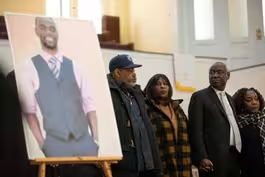
Who's eligible for new COVID boosters and when?
Clip: 4/19/2023 | 5m 25sVideo has Closed Captions
CDC approves new COVID booster shots. Who's eligible and when they can get it?
The government approved a second dose of the COVID booster for the elderly and immunocompromised. The bivalent booster shot targets the omicron variants. Seniors 65 years and older can now receive the updated booster four months after their first dose. Amna Nawaz spoke with Dr. Jeremy Faust to understand why this is a significant move in the fight against COVID.
Problems playing video? | Closed Captioning Feedback
Problems playing video? | Closed Captioning Feedback
Major corporate funding for the PBS News Hour is provided by BDO, BNSF, Consumer Cellular, American Cruise Lines, and Raymond James. Funding for the PBS NewsHour Weekend is provided by...

Who's eligible for new COVID boosters and when?
Clip: 4/19/2023 | 5m 25sVideo has Closed Captions
The government approved a second dose of the COVID booster for the elderly and immunocompromised. The bivalent booster shot targets the omicron variants. Seniors 65 years and older can now receive the updated booster four months after their first dose. Amna Nawaz spoke with Dr. Jeremy Faust to understand why this is a significant move in the fight against COVID.
Problems playing video? | Closed Captioning Feedback
How to Watch PBS News Hour
PBS News Hour is available to stream on pbs.org and the free PBS App, available on iPhone, Apple TV, Android TV, Android smartphones, Amazon Fire TV, Amazon Fire Tablet, Roku, Samsung Smart TV, and Vizio.
Providing Support for PBS.org
Learn Moreabout PBS online sponsorshipAMNA NAWAZ: The government has just approved a second dose of the COVID booster for the elderly and immunocompromised.
The bivalent booster shot targets the Omicron variants.
Seniors 65 years and older can now receive the updated booster four months after their first dose.
Meanwhile, people with weak immune systems can get an additional shot of the vaccine after two months.
To help us understand why this is a significant move in the fight against COVID-19, I'm joined by Dr. Jeremy Faust, emergency physician at Brigham and Women's Hospital in Boston and the author of Inside Medicine on Substack.
Dr. Faust, welcome and thanks for joining us.
These steps are very targeted to vulnerable populations, to seniors and the immunocompromised.
Does this make sense to you as the right move, given where we are in this pseudo-post-pandemic world right now?
DR. JEREMY FAUST, Brigham and Women's Hospital: Thank you for having me.
This move does make sense, because it acknowledges that there is a large spectrum of risk out there.
It is -- a one-size-fits-all approach really wouldn't make sense, treating a 10-year-old with no medical problems with the same vaccine strategy as a 70-year-old who has cancer and is on chemotherapy.
So I think that today's move really addresses that discrepancy and allows for a little -- a little bit of nuance, in terms of how we approach the next phase.
AMNA NAWAZ: At the same time, we should note booster uptake has been very low.
These shots do no good just sitting on the shelves.
Only about 20 percent of all adults have gotten that updated booster since September.
So, isn't that an argument for just opening it up to anyone who wants it?
DR. JEREMY FAUST: Well, there are downsides overboosting.
But in the high-risk population, what wins the day are the upsides.
So, in terms of short-term prevention against severe hospitalizations and mortality, deaths, the benefit for that higher-risk group, the severely immunocompromised, older populations in general, does make it worthwhile, because there could be a downside of overboosting, which is that we are training our immune system to expect a particular virus.
And if we -- if we keep showing it the same thing over and over again, including half of this vaccine, which still has half of the Wuhan virus in it, we actually risk a longer-term increase in infections.
So I really support the idea of zeroing in on the people who need that protection from the serious outcomes, because we know that, in a short period of time, it works very, very well.
AMNA NAWAZ: What about what's ahead, especially for younger and healthy people?
Could we be seeing another shot being offered for them as we move through the summer and into another fall and winter season?
DR. JEREMY FAUST: I think the CDC and the FDA signaling an annual kind of cycle for the general population, the younger, healthier populations, I think that's appropriate.
I think that the value-add of a booster for younger, healthy populations hasn't always been that clear.
We have always lumped in young and healthy with older and sicker when making the booster-for-all argument.
Nowadays, I think we're being a little bit more nuanced.
And so offering it less often for the lower-risk makes a ton of sense.
I do think that, in June, we're going to hear more about what they're going to put into a fall booster.
And I suspect and I hope that it will be a booster that only contains virus that is currently circulating.
In other words, the original virus, the Wuhan strain, really isn't out there anymore.
We are in an Omicron world, and we should be boosting against that virus.
AMNA NAWAZ: Dr. Faust, there has been and continues to be some debate over how we're counting COVID hospitalizations and deaths, not necessarily people alleging nefarious intent here, but saying there's a difference between people who die with COVID versus people who die of COVID.
They say we're counting both and that could be an overcount.
What do you say to that?
DR. JEREMY FAUST: The concept to understand is called excess mortality.
And the idea is, not just are there COVID deaths, but are there more deaths of all causes combined than there should be?
And throughout the pandemic, we have seen, for the most part, there have been -- there's been constant excess mortality that goes way up when we have a wave and comes down after the wave.
And we have very, very rarely seen a time where there were more COVID deaths being counted than there were all excess deaths.
If that were to happen, you would start to think, oh, there's something to that argument.
But, for the most part, it hasn't happened.
It's happened at times.
And, in terms of hospitalizations and other outcomes, again, it's very difficult.
People don't agree when they look at medical charts.
But, actually, when we do that kind of work, I think we do see that, if anything, we're probably undercounting COVID deaths that happen that don't look like COVID deaths, so someone who dies at home, but they never got a COVID test, or someone who died of a diabetic crisis or heart failure exacerbation, and it's chalked up to heart failure or diabetes.
But they never would have had that exacerbation had they not contracted coronavirus the week before.
And so, as long as we have excess mortality and COVID deaths going hand in hand, step by step, it's pretty hard to make an epidemiological argument that would support the overcounting approach.
AMNA NAWAZ: Still striking, over 250 people a day.
That is Dr. Jeremy Faust, emergency physician at Brigham and Women's Hospital in Boston, and author of Inside Medicine on Substack.
Dr. Faust, thank you.
DR. JEREMY FAUST: Thank you.
Home-grown extremism and lessons learned after Oklahoma City
Video has Closed Captions
Clip: 4/19/2023 | 13m 4s | Home-grown extremism and lessons learned 28 years after Oklahoma City bombing (13m 4s)
House Democrats say they will fight for abortion access
Video has Closed Captions
Clip: 4/19/2023 | 7m 15s | Second-highest ranking House Democrat on her party's plans to fight for abortion access (7m 15s)
Providence Art Club a haven for diverse artists since 1880
Video has Closed Captions
Clip: 4/19/2023 | 4m 8s | Providence Art Club a haven for diverse artists since 1880 (4m 8s)
Tyre Nichols' mother sues Memphis, officers who beat him
Video has Closed Captions
Clip: 4/19/2023 | 7m 45s | Tyre Nichols' mother discusses lawsuit against Memphis and officers who beat him (7m 45s)
Ukrainian company uses social media to counter Russia
Video has Closed Captions
Clip: 4/19/2023 | 6m 43s | Ukrainian company uses social media, open source technology to counter Russian invasion (6m 43s)
Providing Support for PBS.org
Learn Moreabout PBS online sponsorshipSupport for PBS provided by:
Major corporate funding for the PBS News Hour is provided by BDO, BNSF, Consumer Cellular, American Cruise Lines, and Raymond James. Funding for the PBS NewsHour Weekend is provided by...
















